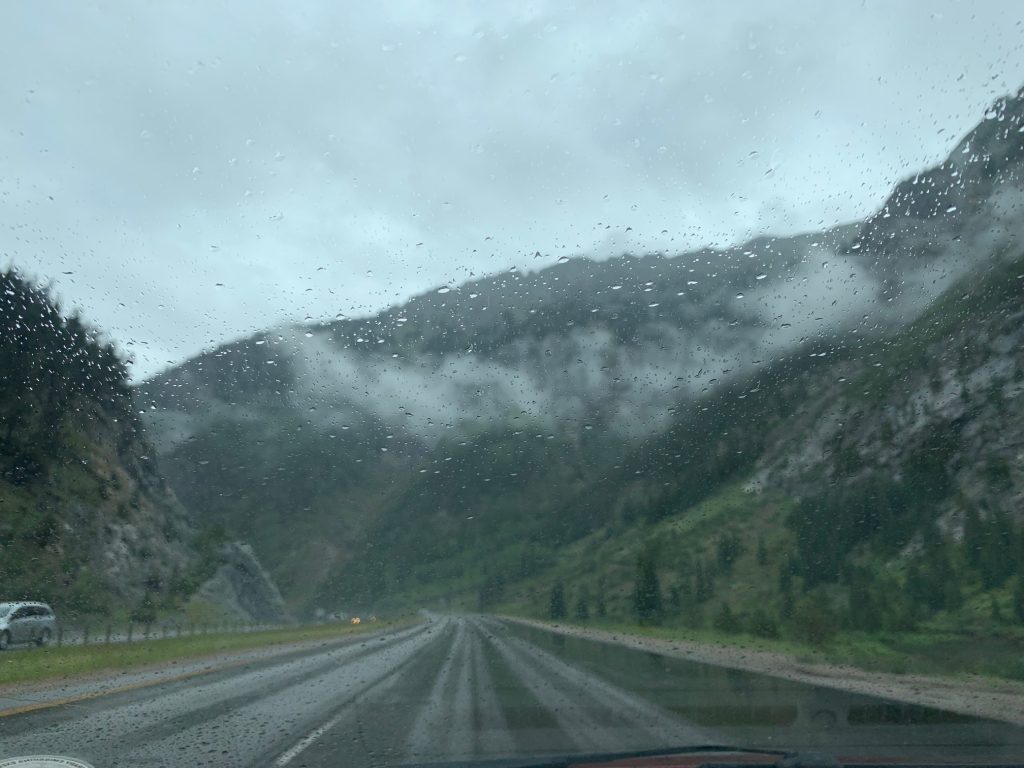Last weekend as I was white-knuckling my steering wheel, going 45 in a 60 mph mountain stretch of I-70 E back towards Denver, and shrieking as a truck splashed a puddle over my windshield, I thought–this is a really good metaphor for the emotional ride of life… If I survive this (dramatic, I know), I should write about that.
When I was younger, I remember feeling condescending, at best, towards people who were traveling slowly on the road. “What’s your problem?!” Now, I sometimes feel annoyed, but then I try and have empathy for what they might be experiencing. What changed for me? Partly, it’s that I was a passenger in a car accident in the rain. And that feeling of hydroplaning out of control on a highway still gets triggered in my body when I’m driving in the rain. Also, I became a parent. Having my child in the backseat when I’m driving makes me much more alert and aware of what could go wrong. So I imagine that if my minor accident and the intensity of parental protectiveness have affected me so much, what might people who have flipped their cars or lost someone they loved to an accident feel on the road?
Driving on the road is, in this respect, an analogy for our own emotional trauma and processing, and our relationship to others in that experience. As we each navigate our journey, we get wounded along the way, develop trauma and triggers for reliving it. Hopefully we remember that, and hold others with empathy.
Rainy weather mixed with steep inclines are a trigger for me. As are less tangible events and interactions. And when that triggering happens, how do I respond?
The Choice
The two best options are 1. I stay the course, through my emotional pain, and find a way to be in it that is safe enough or 2. Pull over, take a break, and freak right on out until the crisis passes or I find a way to wisely re-enter the rainy, emotional road ahead. The third option, driving irresponsible on the road I’m sharing with everyone else, is a dangerous one for me and them.
I chose the first. I stayed on the highway through the pouring rain, and made it as safe as possible. I told my six year old that I was nervous and needed all my attention on the road so he must be quiet. I drove at a speed that was under the limit, but reasonable given the weather, and I was very accommodating to all the SUV drivers who passed around me. I breathed deeply, and we enjoyed as much as possible my “top 200 liked songs” Spotify playlist. I’d like to think that every time I choose to stay in it, in that fear on the road that is somewhat irrational, and I make it though OK, I am healing some of that trauma. But sometimes, the right thing is to “pull over” and create a space apart to process. Examples of that in our lives might be in a therapists office, sacred meditation space, emotional processing techniques, etc.

Empathy, and Accountability
Here’s the balance–is that we have to practice self-love, and empathy for others in their process, while also following the rules of the road and being reasonable in how we engage. Meaning, don’t drive in a way that you are actually putting yourself and others in danger. And if you can’t manage in that moment to do that, take some time to rest, do some emotional work, come back to that high pressure when you’re feeling less triggered. Or when it is no longer so high-pressure (when the rain has dried). In short, do your work, so that you are not blaming or hurting other people. And causing an accident–on the road and in relationships.
Yet here is where the analogy breaks down, because in our close relationships we are probably going to have some fender benders, scratches and bruises, maybe some head-on collisions. It gets messy and hard sometimes. But we don’t have to lose our life, or our connection. We get to have empathy, and hear each other and work it out. But those are topics for other days.
One Response to Driving in Emotional Weather
Sign up for Helena's Blog
Welcome!
I am a coach, facilitator and program director in Denver, Colorado. I bring a high-performance mindset from 18 years leading in global corporations, startups, non-profits and Higher Ed. I’ve also honed skills in emotional intelligence and practical spirituality through training with ICF, Shadow Work®, Insights Discovery and motherhood. If you’re ready to do powerful inner work, and also get tangible results in your external environment, please follow my blog and reach out to talk about coaching!
Recent Comments
- HelenaAnn on The Four Quarter Model
- Mariette Strub on The Four Quarter Model
- Brianna on Tales of a Working Parent in 2020: The 3 Spheres of Attention
- Ruth Buckingham on Driving in Emotional Weather
- Ruth on Keep Your Labels To Yourself, Thanks









Loved the analogy. And the choices, both good, not the tough-it through one being better. I have sometimes thought that. Love…